
There is little in domestic policy in which there is greater agreement than the need to eliminate poverty. Superior mobility, which is provided by the automobile, both in the United States and around the world is one key. David King of Arizona State University, Michael Smart of Rutgers University and Michael Manville of UCLA found that US households without access to vehicles have a 70% greater chance of being in poverty than those who have access to vehicles. (Figure 1)
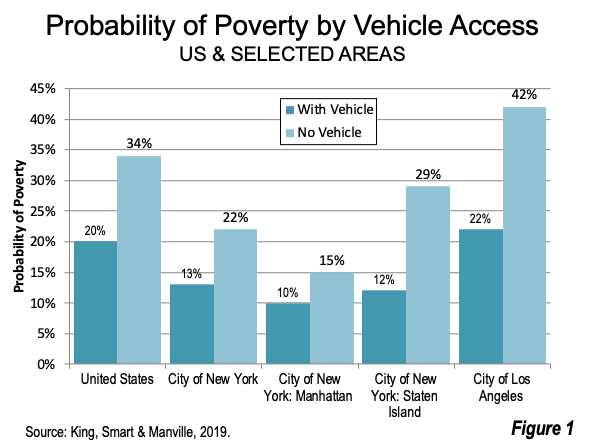
In a 2014 study (Driving to Opportunity), Rolf Pendall of the Urban Institute found a “positive role” of automobiles in outcomes for low-income households. Pendall wrote in CityLab, "The importance of automobiles arises not due to the inherent superiority of driving, but because public transit systems in most metropolitan areas are slow, inconvenient, and lack sufficient metropolitan-wide coverage to rival the automobile.”
The good news is that there has been a nearly five percent drop in the share of no-vehicle households in the last decade. This is based on the American Community Survey 5-year data for 2016-2020 and 2006-2010 for the 56 major metropolitan areas (over 1,000,000 population in the 2020 census). The five year surveys are used because the latest one-year survey (2020) had insufficient data as a result of pandemic difficulties.
Overall, the national data indicates that 8.5% of households did not have access to a vehicle in 2016-2020. This is a 10 year improvement of 4.5% compared to the 8.8% zero vehicle share in 2006-2010.
Lowest Zero-Vehicle Major Metros
Raleigh, NC has the lowest zero-vehicle household share among the 56 major metros, at 3.9%. Seven additional major metros have household zero vehicle shares under 5.0%, including (in order) Nashville, TN, Riverside-San Bernardino, CA, Austin, TX, Dallas-Fort Worth, TX, Orlando, FL, Oklahoma City, OK and Charlotte, NC-SC. The balance of the top 15 includes Salt Lake City, UT, San Jose, CA, Denver, CO, San Diego, CA, Phoenix, AZ and Tulsa, OK. (Figure 2)
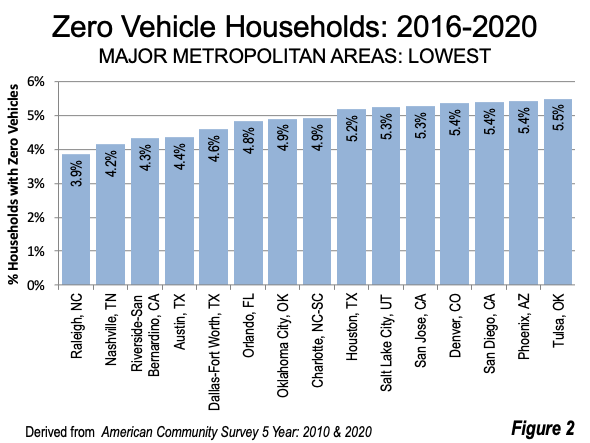
Highest Zero-Vehicle Major Metros
New York, NY-NJ-PA has by far the largest (56th) zero vehicle household rate, at 30.6%. This is nearly 2.5 times the rate of Boston, MA-NH, which has the second highest zero vehicle household rate (12.9%). (Figure 3)
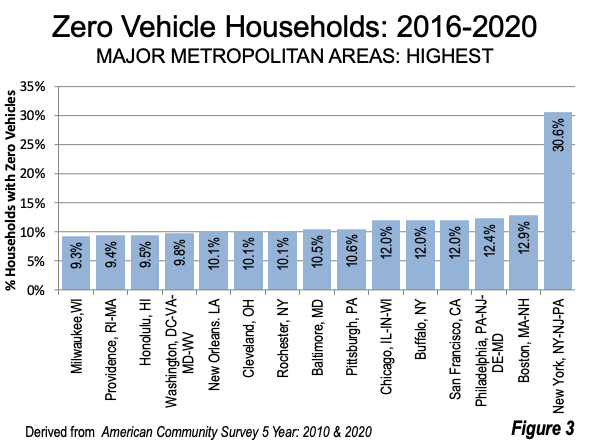
As in so many demographic indicators, New York presents a special case, with a large percentage of households choosing to be without vehicles, as opposed to not being able to afford them. The difference is principally the nature of the urban core — the city of New York, and along with Hudson County, New Jersey (county seat, Jersey City). Their high population densities combined with high frequency rapid transit access to Manhattan, make it possible for middle-income households to rely for their local mobility on walking and transit, while choosing not to have a vehicle. The difference between New York’s high zero-vehicle household share and the other major metros results from this practical choice. Outside this dense, transit intensive core, the rest of the New York metropolitan area (with a population exceeding all metropolitan areas except for Los Angeles) has a zero vehicle household rate of only 9.3%. This is similar to the rates in metropolitan areas like Seattle, Milwaukee and Providence (ranked 41st,42nd and 43rd best, respectively.
Four additional major metros have zero vehicle household rates exceeding 12%, including Philadelphia, PA-NJ-DE-MD, San Francisco, CA, Buffalo, NY and Chicago, IL-IN-WI. Five additional major metros have zero-vehicle household rates over 10%: Pittsburgh, PA, Baltimore, MD, Rochester, NY, Cleveland, OH and New Orleans, LA.
Major Metros with the Largest Vehicle Availability Gains (2006-2010 to 2016-2020)
The share of zero vehicle households declined over the last 10 years in 55 of the 56 major metropolitan area.
Largest Improvements: The most improved vehicle availability was in Nashville, TN, which experienced a 19.9% decrease in the share of zero vehicle households over 10 years. Four more major metros experienced improvements of 15% or more, including, in order, Raleigh, NC, Denver, CO, San Antonio, TX and Charlotte, NC-SC. Seven others experienced reductions in their zero vehicle household rates of at least 10%, including Houston, TX, Austin, TX, Fresno, CA, Phoenix, AZ, Cincinnati, OH-KY-IN, San Diego, CA and Columbus, OH (Figure 4).
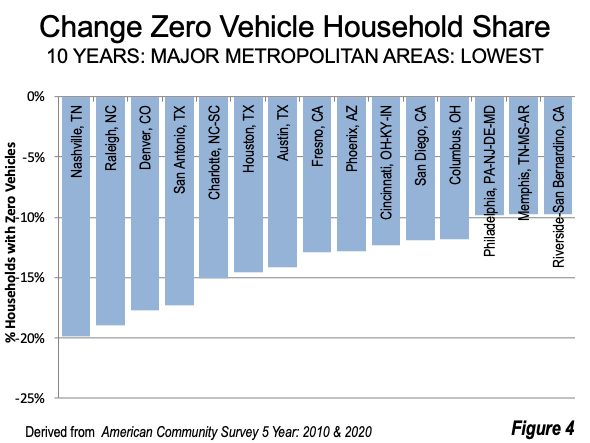
Losses and More Modest Improvements: The largest increase was in Seattle, WA, where the share of zero vehicle households increased 12%. New Orleans, LA and Las Vegas, NV had increases of 6% in their zero vehicle households (Figure 5).
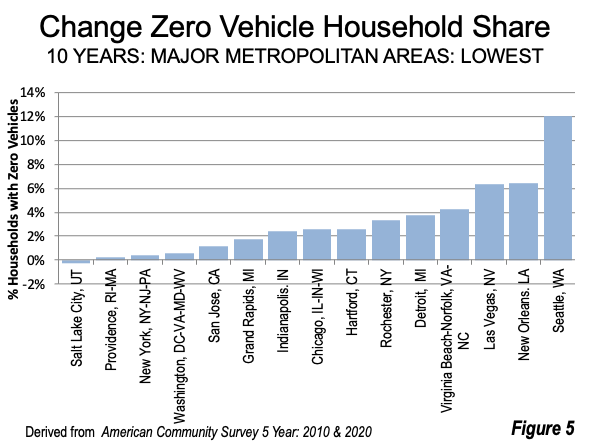
How Vehicle Availability Improves Job Access
With job access within 30 minutes by car averaging 55 times that of transit (not 55%, but 5,500%), the reduction in zero vehicle households represents an important advance. Margy Waller of the Progressive Policy Institute may have said it best: “In most cases, the shortest distance between a poor person and a job is along a line driven in a car.”
Note: Portions of the above are adapted from our previous article, The Limits of Being Near Transit.
Wendell Cox is principal of Demographia, an international public policy firm located in the St. Louis metropolitan area. He is a founding senior fellow at the Urban Reform Institute, Houston, a Senior Fellow with the Frontier Centre for Public Policy in Winnipeg and a member of the Advisory Board of the Center for Demographics and Policy at Chapman University in Orange, California. He has served as a visiting professor at the Conservatoire National des Arts et Metiers in Paris. His principal interests are economics, poverty alleviation, demographics, urban policy and transport. He is co-author of the annual Demographia International Housing Affordability Survey and author of Demographia World Urban Areas.
Mayor Tom Bradley appointed him to three terms on the Los Angeles County Transportation Commission (1977-1985) and Speaker of the House Newt Gingrich appointed him to the Amtrak Reform Council, to complete the unexpired term of New Jersey Governor Christine Todd Whitman (1999-2002). He is author of War on the Dream: How Anti-Sprawl Policy Threatens the Quality of Life and Toward More Prosperous Cities: A Framing Essay on Urban Areas, Transport, Planning and the Dimensions of Sustainability.
Photo: Raleigh, North Carolina (urban core): Major metropolitan area with the lowest zero-vehicle household rate and best auto availability rate. By Dennis Ludlow, via Wikimedia under CC 4.0 License.













Loans
Although the link of vehicle possession to poverty may be a correlation (outside of NYC) and not causal, and therefore not corrective of poverty, this is an interesting measure of actual living standards going up. However, if the additional vehicle access is from easy-lending practices that mask actual ability to pay, these gains could be illusory.